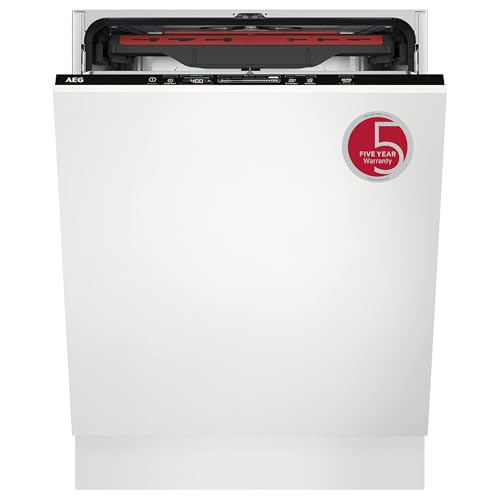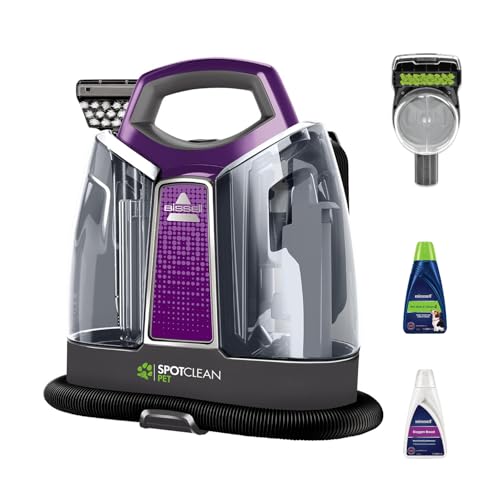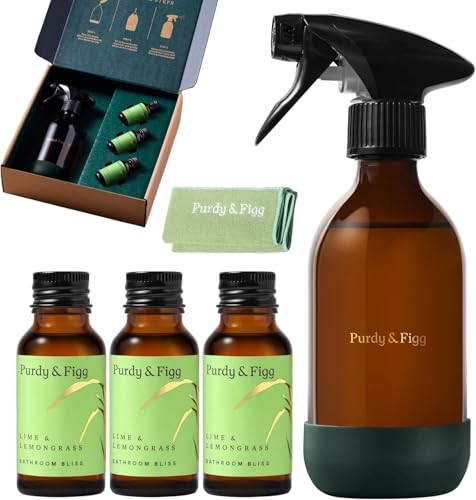




Orange juice is a popular breakfast beverage loved by many for its refreshing taste and rich vitamin C content. However, if not handled carefully, it has the potential to cause stubborn stains on clothes and carpets. The bright orange color of the juice comes from the natural pigment called carotenoids, which can adhere to fabrics and carpets, leaving behind a noticeable stain.
When orange juice spills on clothes, it’s important to act quickly. Blot the area with a clean cloth or paper towel to absorb as much liquid as possible. Avoid rubbing, as this can push the stain further into the fabric. Rinse the stained area with cold water, then treat it with a pre-wash stain remover or a mixture of liquid laundry detergent and water. Let it sit for a few minutes before laundering as usual.
Carpet stains can be even more difficult to remove, especially if the orange juice has had time to dry. Begin by blotting up any excess liquid with a clean cloth or paper towel. Then, mix a solution of one teaspoon of mild dishwashing liquid, one tablespoon of white vinegar, and two cups of warm water. Apply the solution to the stain using a clean cloth, and gently blot the area. Rinse with cold water and blot dry.
To prevent orange juice stains in the first place, it’s advisable to be cautious while enjoying this delicious drink. Use a straw to minimize contact with the lips and teeth, and handle the glass or cup carefully to avoid spills. Additionally, consider wearing an apron or using a placemat when drinking orange juice to protect your clothing and surfaces.
Remember, prevention is always better than cure when it comes to orange juice stains. However, if a stain does occur, prompt action and the right cleaning methods can help to minimize its impact. With a little care and attention, you can continue to enjoy your morning glass of orange juice without worrying about potential stains.
Can Orange Juice Stain Clothes and Carpets?
Orange juice is a popular and refreshing drink that many people enjoy. However, accidents can happen and spills can occur, potentially causing stains on clothes and carpets. Here, we will explore whether orange juice can indeed leave stains and how to effectively deal with such stains.
1. Why can orange juice cause stains?
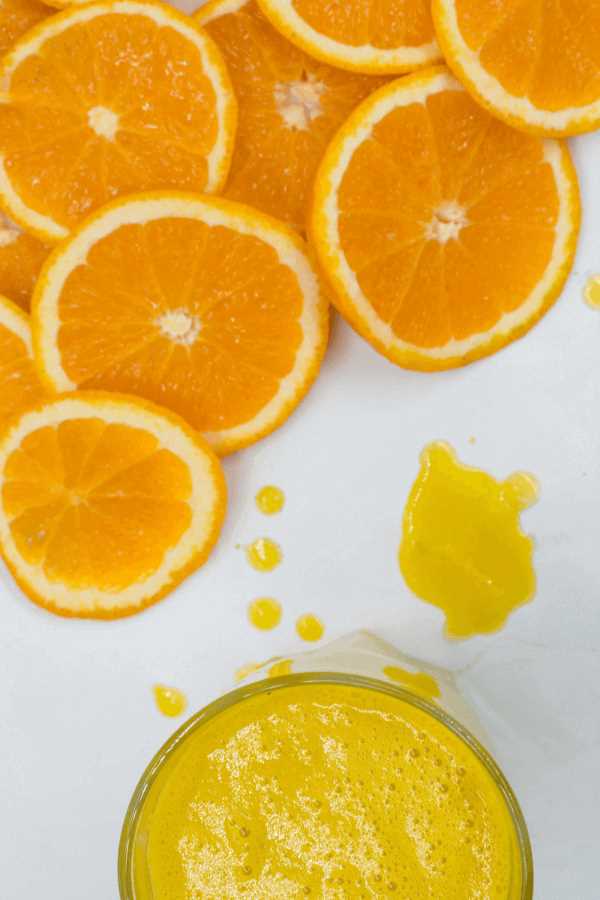
Orange juice contains natural pigments called anthocyanins and beta-carotene, which are responsible for its vibrant orange color. These pigments can easily penetrate fabric fibers and adhere to them, leading to permanent discoloration if not treated promptly.
2. How to prevent orange juice stains?
- Be cautious and handle orange juice with care to minimize spills.
- Use spill-proof cups or containers to reduce the chances of accidental spills.
- Consider using a straw when drinking orange juice to limit the risk of splashing.
- Always blot or dab the spilled area gently, avoiding any rubbing motion that may further embed the pigment into the fabric or carpet fibers.
3. How to remove orange juice stains from clothes?
To remove an orange juice stain from clothes, follow these steps:
- Act quickly and blot any excess liquid with a clean cloth or paper towel.
- Rinse the stained area with cold water from the back of the fabric to help flush out the pigments.
- Pre-treat the stain by applying a stain remover or a mixture of mild detergent and water. Let it sit for a few minutes.
- Gently rub the fabric together to work the detergent into the stain, being careful not to damage the fabric.
- Wash the garment in the washing machine according to the care instructions.
- Check if the stain is completely removed before drying the garment. If the stain persists, repeat the steps or consider seeking professional help.
4. How to remove orange juice stains from carpets?
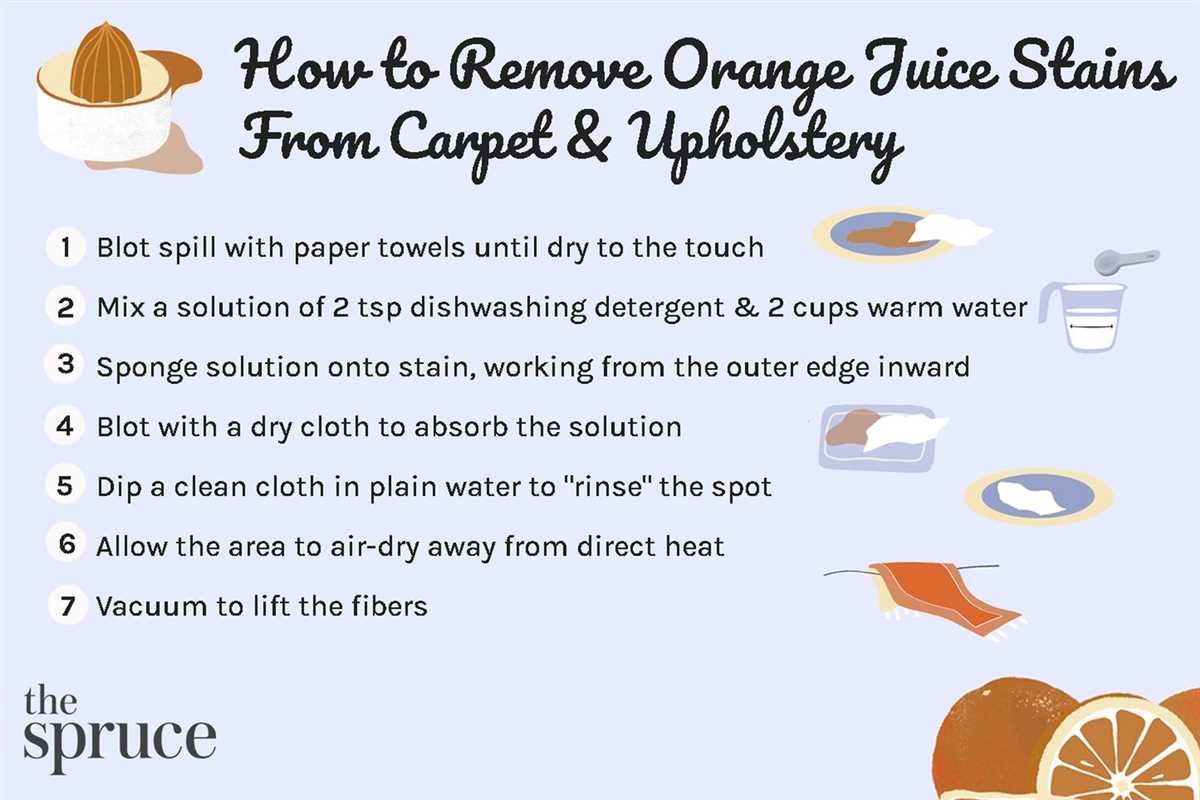
Here is a step-by-step guide to remove orange juice stains from carpets:
- Blot the stain immediately with a clean cloth or paper towel to absorb as much liquid as possible.
- Mix a solution of mild dish soap and warm water.
- Dampen a clean cloth in the soapy solution and gently blot the stained area, starting from the outer edge and moving towards the center.
- Continue blotting until the stain is removed. Avoid rubbing or scrubbing, as it may damage the carpet fibers.
- Rinse the area with cold water and blot dry with a clean cloth.
- If the stain persists, consider using a carpet stain remover according to the manufacturer’s instructions or consult a professional carpet cleaner.
By following these tips, you can effectively deal with orange juice stains on clothes and carpets and keep them looking clean and fresh.
The Potential of Orange Juice stains
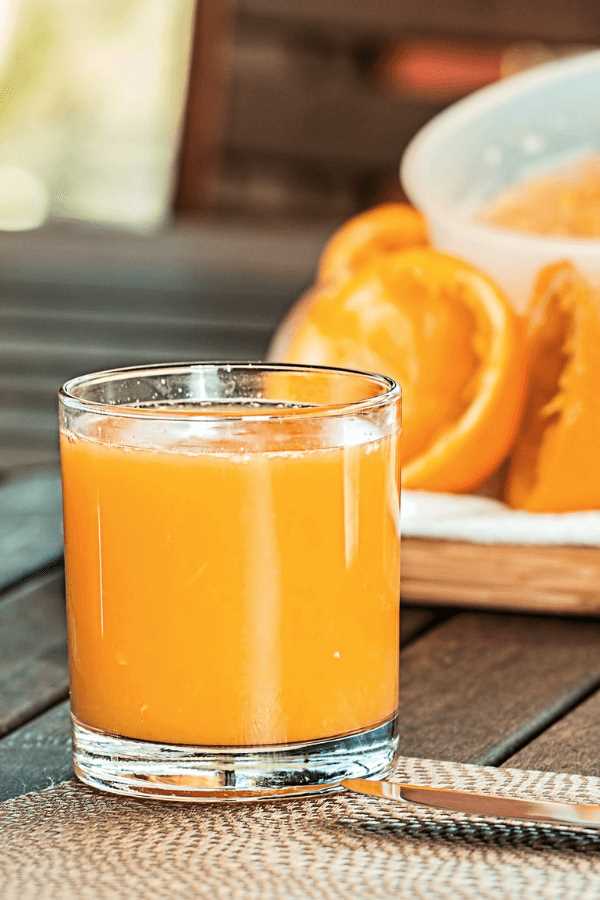
Orange juice is a delicious and refreshing beverage that many people enjoy as part of their daily routine. However, it can also be a potential source of stains on clothes and carpets. The acidic nature of orange juice, along with its vibrant color, can make it a challenging stain to remove.
When orange juice comes into contact with fabrics, it can quickly seep into the fibers and create a stain. The natural pigments in orange juice can cause discoloration, particularly on lighter fabrics. Additionally, the acid in the juice can weaken the fabric and make it more susceptible to damage.
Orange juice stains on clothes can be particularly challenging to remove if not treated promptly. The longer the stain remains on the fabric, the deeper it can penetrate, making it more difficult to remove completely. It is crucial to take immediate action to prevent the stain from setting.
Removing orange juice stains from clothes and carpets requires a combination of proper techniques and cleaning agents. A mild detergent or stain remover can be used to pretreat the area before laundering or cleaning the affected item. It is essential to follow the manufacturer’s instructions for both the cleaning agent and the fabric.
If you are dealing with a fresh orange juice stain, you can try blotting the excess liquid with a clean cloth or paper towel. Avoid rubbing the stain, as this can spread it further and make it more challenging to remove. Gently blotting the stain can help absorb the liquid and prevent it from spreading.
In the case of carpets, it is important to act quickly to prevent the stain from setting. Start by blotting the stain with a clean cloth to remove as much liquid as possible. Then, mix a solution of mild detergent and warm water and apply it to the stain using a clean cloth or sponge. Blot the stain gently until it starts to lift. Rinse the area with clean water and blot it dry.
Preventing orange juice stains can be as simple as taking precautions. Avoid placing cups or glasses filled with orange juice on unstable surfaces or near fabrics that can easily absorb the liquid. If a spill does occur, it is essential to clean it up promptly to minimize the chances of a stain.
In conclusion, orange juice stains can be a potential inconvenience and challenge to remove from clothes and carpets. Taking immediate action and using proper cleaning techniques can help prevent these stains from becoming permanent. By being proactive and practicing caution, you can enjoy your orange juice without worrying about unsightly stains.
Understanding the Staining Process
When it comes to understanding why orange juice can cause stains on clothes and carpets, it’s important to consider the components of orange juice and how they interact with textiles.
1. Pigments:

Orange juice contains pigments that give it its vibrant color. These pigments can easily transfer onto fabrics and carpets upon contact.
2. Acidity:

Orange juice is acidic in nature, with a pH level of around 3. This acidity can weaken the fibers of fabrics and make them more susceptible to staining.
3. Sugars:
Orange juice contains natural sugars that can act as a sticky substance on fabrics. These sugars can attract dirt and other particles, further exacerbating the staining process.
4. Time:
The longer orange juice remains on a fabric or carpet, the more time it has to seep into the fibers and cause a deep-set stain. It is important to act quickly when a spill occurs to minimize the potential for staining.
5. Absorbency:
The absorbency of the fabric or carpet also plays a role in the staining process. Fabrics with low absorbency may repel the orange juice, while more absorbent materials will soak it up, increasing the likelihood of staining.
6. Fabric Type:
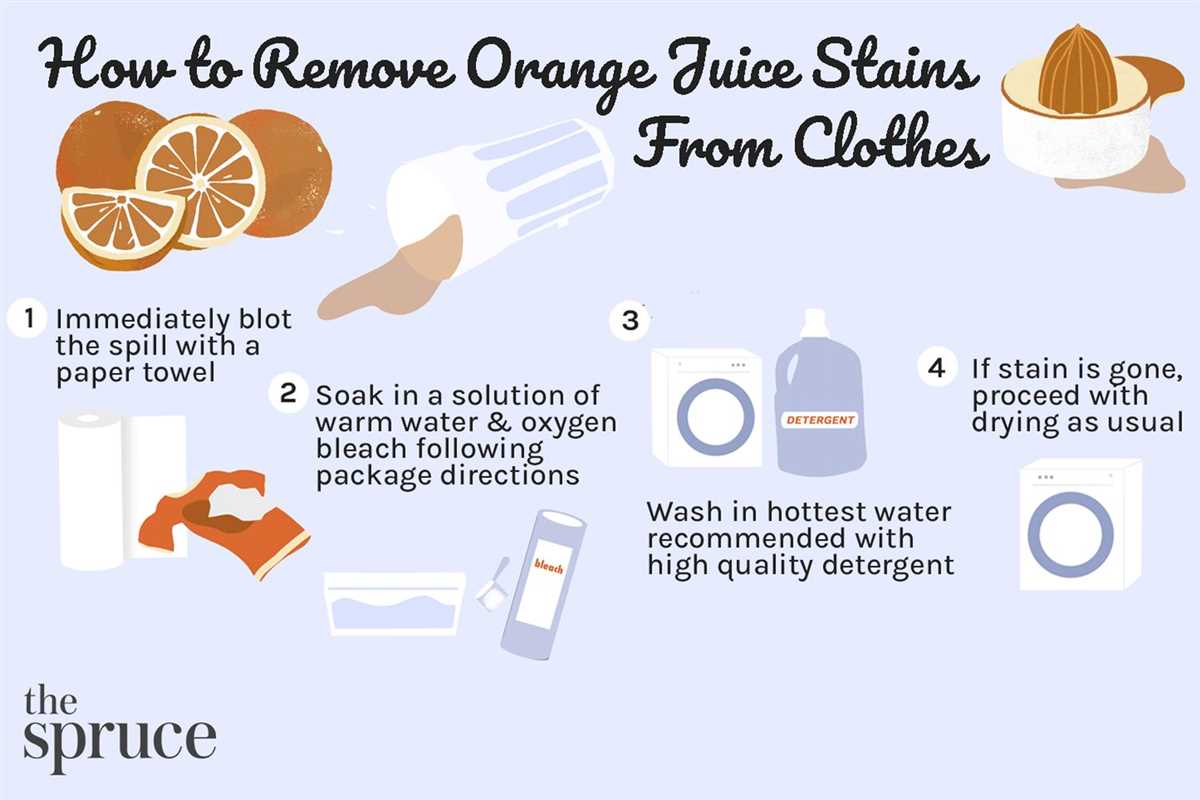
The type of fabric can determine how easily orange juice stains. Natural fibers, such as cotton and wool, are more susceptible to staining compared to synthetic fibers like nylon or polyester.
7. Pigment Removal:
Removing the pigments from orange juice stains can be challenging. The pigments can penetrate the fibers and may require specialized stain removers or professional cleaning to fully remove.
By understanding the staining process, it becomes clear why orange juice can cause stubborn stains on clothes and carpets. Taking quick action and using appropriate cleaning methods can help minimize the damage caused by these stains.
Tips for Removing Orange Juice Stains
1. Act quickly
When an orange juice spill occurs, it’s important to act quickly to prevent the stain from setting into the fabric or carpet.
2. Blot the stain

Start by blotting the stain with a clean cloth or paper towel to remove as much of the liquid as possible. Avoid rubbing the stain, as this can push it deeper into the fibers.
3. Rinse with cold water
After blotting, rinse the stained area with cold water to further remove the juice. Hold the fabric or carpet under running water or use a damp cloth to gently rinse the stain.
4. Treat with detergent
Apply a small amount of liquid detergent directly to the stain and gently rub it in using your fingers or a soft brush. Let the detergent sit on the stain for a few minutes to break down the organic compounds in the juice.
5. Rinse and repeat
Rinse the stained area again with cold water to remove the detergent. Repeat the detergent application and rinsing process as necessary until the stain is fully removed.
6. Use a stain remover
If the stain persists, you can use a commercial stain remover specifically designed for removing fruit juice stains. Follow the instructions on the product and make sure to test it on a small, inconspicuous area first to ensure it doesn’t cause any damage.
7. Launder or clean as usual

Once the stain has been successfully removed, launder the fabric according to its care instructions. For carpets, you may need to use a carpet cleaner or call a professional cleaner if the stain is particularly stubborn.
8. Prevention is key
To avoid future orange juice stains, consider using spill-proof containers or pouring drinks over a sink or countertop instead of on carpets or fabrics.
By following these tips, you can effectively remove orange juice stains from your clothes and carpets, keeping them clean and fresh.
Precautions to Prevent Staining
While it can be challenging to completely avoid spills and stains when working with orange juice, there are several precautions you can take to minimize the risk. Follow these guidelines to help prevent orange juice from causing stains on your clothes and carpets:
- Use a spill-proof container: When drinking or handling orange juice, opt for a spill-proof container with a secure lid. This can help prevent any accidental spills or leaks that could result in stains.
- Handle with care: Be careful when pouring orange juice to avoid any splashes or drips. Pour slowly and steadily to minimize the chances of the liquid splattering onto clothing or carpets.
- Wear an apron: Consider wearing an apron or protective clothing while handling orange juice, especially if you’re preparing a large quantity or are prone to spills. This can help shield your clothes from potential stains.
- Act quickly: If a spill does occur, it’s crucial to address it promptly. Blot the affected area with a clean cloth or paper towel to soak up as much of the orange juice as possible. Avoid rubbing, as this can spread the stain further.
- Use stain removers: For stubborn stains, use a stain remover that’s suitable for the type of fabric or surface you’re dealing with. Follow the instructions provided with the product and test it on a small, inconspicuous area first.
- Consider professional cleaning: If all else fails and the stain remains, it may be best to seek professional cleaning services. They have specialized tools and expertise to tackle tough stains effectively.
By following these precautions and acting quickly in the event of a spill, you can minimize the chances of orange juice causing unsightly stains on your clothes and carpets.
FAQ
Does orange juice cause stains on clothes and carpets?
Yes, orange juice can cause stains on clothes and carpets due to its natural pigments and acidic properties. It’s important to act quickly to prevent the stain from setting in.
How can I remove orange juice stains from clothes?
To remove orange juice stains from clothes, start by blotting the stain with a clean cloth or paper towel to absorb any excess liquid. Then, rinse the area with cold water and apply a pre-treatment stain remover. Let it sit for a few minutes before laundering the garment as usual.
What should I do if I spill orange juice on my carpet?
If you spill orange juice on your carpet, quickly grab a clean cloth or paper towel and blot the stain to absorb as much liquid as possible. Avoid rubbing the stain, as it can make it spread. Once you’ve removed most of the liquid, dilute the stain with a mixture of water and mild detergent, then blot again. Rinse the area with water and blot until dry.
Can I use bleach to remove orange juice stains?
No, it’s not recommended to use bleach to remove orange juice stains. Bleach can react with the natural pigments in orange juice and lead to discolouration or damage to the fabric. It’s best to use a stain remover specifically designed for removing food stains.
Are there any home remedies to remove orange juice stains?
Yes, there are a few home remedies you can try to remove orange juice stains. One option is to mix equal parts vinegar and water and use it as a pre-treatment solution. Another option is to make a paste using baking soda and water, apply it to the stain, let it dry, then brush it off and rinse with water. Keep in mind that these remedies may not work for all types of fabric, so it’s always best to test on a small, inconspicuous area first.
What if the orange juice stain has already dried?
If the orange juice stain has already dried, you can try moistening it with a mixture of water and vinegar, then blotting with a clean cloth to lift the stain. You can also use a commercial stain remover and follow the instructions on the packaging. For stubborn stains, it’s recommended to take the garment to a professional cleaner.
Can I prevent orange juice stains from happening?
While it’s not always possible to prevent orange juice stains from happening, there are a few measures you can take to minimize the risk. You can use spill-proof cups or containers with tight lids to avoid accidental spills. If you do spill orange juice, try to act quickly and follow the appropriate stain removal steps to prevent the stain from setting in.

